A Bias in the Prediction of Tastes - Carnegie Mellon University
A Bias in the Prediction of Tastes - Carnegie Mellon University
A Bias in the Prediction of Tastes - Carnegie Mellon University
You also want an ePaper? Increase the reach of your titles
YUMPU automatically turns print PDFs into web optimized ePapers that Google loves.
The Economic Journal, 105 (July), 929-937. ? Royal Economic Society I995. Published by Blackwell<br />
Publishers, io8 Cowley Road, Oxford OX4 iJF, UK and 238 Ma<strong>in</strong> Street, Cambridge, MA 02I42, USA.<br />
A BIAS IN THE PREDICTION OF TASTES*<br />
George Loewenste<strong>in</strong> and Daniel Adler<br />
Recent research has documented an 'endowment effect' whereby people become more attached to<br />
objects <strong>the</strong>y receive than would be predicted from <strong>the</strong>ir prior desire to possess <strong>the</strong> object. In two<br />
experiments, we test whe<strong>the</strong>r people are aware <strong>of</strong> <strong>the</strong> effect - whe<strong>the</strong>r <strong>the</strong>y realise that <strong>the</strong>y will<br />
become attached to an object once <strong>the</strong>y receive it. In both experiments, subjects without an object<br />
underestimated how much <strong>the</strong>y would value <strong>the</strong> object when <strong>the</strong>y received it.<br />
Although <strong>the</strong> standard economic <strong>the</strong>ory <strong>of</strong> consumer preference assumes fixed<br />
tastes, <strong>the</strong> idea that tastes change over time is not controversial. Numerous<br />
'habit formation' models have been proposed which assume that current<br />
consumption <strong>in</strong>fluences future tastes (Duesenberry, I 952; Pollak, I 970; Stigler<br />
and Becker, I977). These models have been applied to such diverse phenomena<br />
as <strong>the</strong> development <strong>of</strong> tastes for music and food, substance addiction (Becker<br />
and Murphy, I 990) , and <strong>the</strong> surpris<strong>in</strong>gly high rate <strong>of</strong> return on equities relative<br />
to fixed-<strong>in</strong>come securities (e.g. Constant<strong>in</strong>edes, I990).<br />
Although it is more complicated to model than fixed tastes, <strong>the</strong>re is noth<strong>in</strong>g<br />
<strong>in</strong>tr<strong>in</strong>sically irrational about habit formation as long as economic agents can<br />
predict without bias <strong>the</strong> effect <strong>of</strong> <strong>the</strong>ir current behaviour on <strong>the</strong>ir own future<br />
tastes. If people are aware <strong>of</strong> <strong>the</strong> effect <strong>of</strong> <strong>the</strong>ir actions on <strong>the</strong>ir own future<br />
tastes, <strong>the</strong>y can adjust <strong>the</strong>ir consumption <strong>in</strong> a rational manner - e.g. by<br />
desist<strong>in</strong>g from crack based on anticipation <strong>of</strong> future disutility from addiction.<br />
There is some evidence, however, po<strong>in</strong>t<strong>in</strong>g to situations <strong>in</strong> which people<br />
systematically mispredict <strong>the</strong>ir own tastes. For example Ausubel (i99i) noted<br />
that large numbers <strong>of</strong> credit card users expect to ma<strong>in</strong>ta<strong>in</strong> a zero credit balance<br />
but fail to do so - apparently underestimat<strong>in</strong>g <strong>the</strong>ir own future desire for<br />
spend<strong>in</strong>g. This self-forecast<strong>in</strong>g error can expla<strong>in</strong> <strong>the</strong> downward stick<strong>in</strong>ess <strong>of</strong><br />
credit card <strong>in</strong>terest rates s<strong>in</strong>ce consumers who expect to ma<strong>in</strong>ta<strong>in</strong> zero card<br />
balances will not care about credit card <strong>in</strong>terest rates. A similar pattern occurs<br />
<strong>in</strong> connection with consumer rebate programmes; consumer purchase decisions<br />
are quite sensitive to rebate <strong>of</strong>fers, but very few consumers ultimately send <strong>in</strong><br />
<strong>the</strong> forms required to obta<strong>in</strong> <strong>the</strong> rebate (Tat et al. I988).<br />
Our specific focus is on whe<strong>the</strong>r people are able to predict changes <strong>in</strong> <strong>the</strong>ir<br />
own tastes caused by <strong>the</strong> 'endowment effect' (Thaler, I980). The endowment<br />
effect refers to <strong>the</strong> tendency for people to value an object more highly if <strong>the</strong>y<br />
possess it than <strong>the</strong>y would value <strong>the</strong> same object if <strong>the</strong>y did not. In <strong>the</strong> typical<br />
demonstration <strong>of</strong> <strong>the</strong> endowment effect (see, e.g. Kahneman et al. I990), one<br />
group <strong>of</strong> subjects (sellers) are endowed with an object and are given <strong>the</strong> option<br />
<strong>of</strong> trad<strong>in</strong>g it for various amounts <strong>of</strong> cash; ano<strong>the</strong>r group (choosers) are not<br />
given <strong>the</strong> object but are given a series <strong>of</strong> choices between gett<strong>in</strong>g <strong>the</strong> object or<br />
* We thank Max Bazerman, Baruch Fischh<strong>of</strong>f, Col<strong>in</strong> Camerer, Drazen Prelec, and Shane Frederick for<br />
helpful comments and suggestions, and T<strong>in</strong>a Diekman for assistance <strong>in</strong> runn<strong>in</strong>g <strong>the</strong> experiments. The idea<br />
for <strong>the</strong> first experiments arose <strong>in</strong> a discussion with Daniel Kahneman.<br />
[ 929 ]
930 THE ECONOMIC JOURNAL [JULY<br />
gett<strong>in</strong>g various amounts <strong>of</strong> cash. Although <strong>the</strong> objective wealth position <strong>of</strong> <strong>the</strong><br />
two groups is identical, as are <strong>the</strong> choices <strong>the</strong>y face, endowed subjects hold out<br />
for significantly more money than those who are not endowed. As Tversky and<br />
Kahneman (i 991 ) have shown, <strong>the</strong> endowment effect implies that <strong>in</strong>difference<br />
curves shift <strong>in</strong> a systematic manner when <strong>in</strong>dividuals acquire goods - <strong>in</strong>creas<strong>in</strong>g<br />
<strong>the</strong> valuation <strong>of</strong> <strong>the</strong> endowed good relative to all o<strong>the</strong>r goods. Thus, <strong>the</strong><br />
endowment effect can be viewed as a type <strong>of</strong> endogenous taste-change.<br />
Tversky and Kahneman analyse <strong>the</strong> effect <strong>of</strong> endowments on preferences<br />
with a 'reference-dependent preference structure' that <strong>in</strong>dexes <strong>the</strong> standard<br />
preference relations (>-, X, , etc.) accord<strong>in</strong>g to <strong>the</strong> <strong>in</strong>dividual's po<strong>in</strong>t <strong>of</strong><br />
reference (typically <strong>the</strong> current asset position). For example, x -ry <strong>in</strong>dicates<br />
that an <strong>in</strong>dividual with reference position r is <strong>in</strong>different between alternatives<br />
x and y. The sell<strong>in</strong>g price (s) and choice value (c) estimated <strong>in</strong> <strong>the</strong> experimental<br />
setup just described are represented <strong>in</strong> equations i and 2 respectively, where<br />
<strong>the</strong> first argument <strong>of</strong> each pair <strong>in</strong>dicates <strong>the</strong> <strong>in</strong>dividual's level <strong>of</strong> wealth, <strong>the</strong><br />
second designates possession (i) or nonpossession (o) <strong>of</strong> <strong>the</strong> object, and <strong>the</strong><br />
preference relation is subscripted accord<strong>in</strong>g to whe<strong>the</strong>r <strong>the</strong> decision maker is <strong>in</strong><br />
possession <strong>of</strong> <strong>the</strong> object. I) (w + s) (I)<br />
(W) I) o (W + CO) (2)<br />
The endowment effect implies s > c.<br />
To accommodate predictions <strong>of</strong> preferences with<strong>in</strong> this framework, we<br />
generalise <strong>the</strong> notation by subscript<strong>in</strong>g <strong>the</strong> preference relation by <strong>the</strong> asset<br />
position which <strong>the</strong> <strong>in</strong>dividual is attempt<strong>in</strong>g to predict, and superscript<strong>in</strong>g it by<br />
<strong>the</strong> <strong>in</strong>dividual's current reference level. Thus, for an <strong>in</strong>dividual with asset<br />
pos'tion s, -r represents <strong>the</strong> <strong>in</strong>difference relations she would expect to prevail<br />
if her asset position were r <strong>in</strong>stead <strong>of</strong> s.1<br />
In <strong>the</strong> experiments presented below, we asked subjects to predict <strong>the</strong>ir own<br />
sell<strong>in</strong>g price for an object <strong>the</strong>y did not have - i.e. to predict a sell<strong>in</strong>g price, s',<br />
as def<strong>in</strong>ed byw,<br />
)<br />
(w+s',o)<br />
(W,<br />
I ) 1 (W 3) ,O<br />
If subjects predict <strong>the</strong>ir own sell<strong>in</strong>g prices without bias, <strong>the</strong>n, on average, s' = s.<br />
Our prediction is that subjects will underestimate s - i.e. s' g s.<br />
The endowment effect has several advantages as <strong>the</strong> focus <strong>of</strong> a study <strong>of</strong> tastechange<br />
prediction. First, <strong>the</strong> effect operates very rapidly so that, unlike, for<br />
example, changes <strong>in</strong> <strong>the</strong> taste for classical music, it can be studied <strong>in</strong> a s<strong>in</strong>gle<br />
experimental session. Second, discovery <strong>of</strong> a bias <strong>in</strong> predict<strong>in</strong>g <strong>the</strong> impact <strong>of</strong> <strong>the</strong><br />
endowment effect would have far-reach<strong>in</strong>g implications for economics. The<br />
endowment effect refers to <strong>the</strong> impact on tastes <strong>of</strong> merely acquir<strong>in</strong>g a good.<br />
S<strong>in</strong>ce many economic decisions, <strong>in</strong>clud<strong>in</strong>g most decisions <strong>in</strong>volv<strong>in</strong>g consumer<br />
choice, <strong>in</strong>volve acquisitions, documentation <strong>of</strong> a bias <strong>in</strong> <strong>the</strong> prediction <strong>of</strong> <strong>the</strong><br />
endowment effect would call <strong>in</strong>to question <strong>the</strong> rationality <strong>of</strong> a wide range <strong>of</strong><br />
economic behaviour. F<strong>in</strong>ally, we believed that <strong>the</strong>re was a high likelihood <strong>of</strong><br />
observ<strong>in</strong>g a prediction bias <strong>in</strong> this particular doma<strong>in</strong>. This <strong>in</strong>tuition is based<br />
1 Under <strong>the</strong> generalised notation, <strong>the</strong> conventional endowment effect can be expressed as: (w, i)<br />
o), and (w, i) (w (W+c,o), with s > c.<br />
K Royal Economic Society I995<br />
-<br />
(w + s,
I995] THE PREDICTION OF TASTES 93I<br />
on, first, <strong>the</strong> surpris<strong>in</strong>gly long time it has taken social scientists to discover <strong>the</strong><br />
effect, given its magnitude and robustness; second, <strong>the</strong> fact that <strong>the</strong> endowment<br />
effect disappears when people make valuation decisions on behalf <strong>of</strong> ano<strong>the</strong>r<br />
person, as if <strong>the</strong>y are not aware that o<strong>the</strong>rs will get attached to objects <strong>in</strong> <strong>the</strong>ir<br />
possession (Marshall et al. I987); and third, <strong>the</strong> fact that o<strong>the</strong>r studies have<br />
found that people tend to underestimate how quickly <strong>the</strong>y will adapt to<br />
changed circumstances such as w<strong>in</strong>n<strong>in</strong>g a lottery or becom<strong>in</strong>g paraplegic<br />
(Brickman et al. I978) - i.e. that <strong>the</strong>y underestimate <strong>the</strong> impact <strong>of</strong> reference<br />
po<strong>in</strong>t shifts.<br />
I. EXPERIMENT I<br />
The first experiment was designed to test whe<strong>the</strong>r subjects without an object<br />
could predict how attached <strong>the</strong>y would become if <strong>the</strong>y were endowed with it.<br />
We first elicited hypo<strong>the</strong>tical sell<strong>in</strong>g prices for an object from unendowed<br />
subjects <strong>the</strong>n endowed <strong>the</strong>m with <strong>the</strong> object and elicited an actual sell<strong>in</strong>g price.<br />
Subjects were 27 undergraduates enrolled <strong>in</strong> a core humanities class at<br />
<strong>Carnegie</strong> <strong>Mellon</strong> <strong>University</strong> and 42 adults enrolled <strong>in</strong> two even<strong>in</strong>g classes <strong>in</strong><br />
f<strong>in</strong>ance at <strong>the</strong> <strong>University</strong> <strong>of</strong> Pittsburgh. In each class, <strong>the</strong> experimenter held up<br />
a mug engraved with <strong>the</strong> school logo for <strong>the</strong> students to see. A different style<br />
<strong>of</strong> mug was used at <strong>Carnegie</strong> <strong>Mellon</strong> and at <strong>the</strong> <strong>University</strong> <strong>of</strong> Pittsburgh. A<br />
form was <strong>the</strong>n randomly distributed to approximately half <strong>of</strong> <strong>the</strong> students <strong>in</strong><br />
each class. The form asked <strong>the</strong> students to imag<strong>in</strong>e that <strong>the</strong>y possessed <strong>the</strong> mug<br />
on display and to predict whe<strong>the</strong>r <strong>the</strong>y would be will<strong>in</strong>g to exchange <strong>the</strong> mug<br />
for various amounts <strong>of</strong> money. It was worded as follows:<br />
We are <strong>in</strong>terested <strong>in</strong> your op<strong>in</strong>ion about <strong>the</strong> mug displayed at <strong>the</strong> front <strong>of</strong><br />
<strong>the</strong> room. Imag<strong>in</strong>e that we gave you a mug exactly like <strong>the</strong> one you can<br />
see, and that we gave you <strong>the</strong> opportunity to keep it or trade it for some<br />
money. Below are a series <strong>of</strong> l<strong>in</strong>es marked 'Keep mug__ Trade it for<br />
$ amount .' On each l<strong>in</strong>e check whe<strong>the</strong>r you th<strong>in</strong>k that you would<br />
prefer to keep <strong>the</strong> mug or to trade it <strong>in</strong> for <strong>the</strong> amount <strong>of</strong> money written<br />
on <strong>the</strong> l<strong>in</strong>e. Check one or <strong>the</strong> o<strong>the</strong>r on every l<strong>in</strong>e.<br />
The rema<strong>in</strong>der <strong>of</strong> <strong>the</strong> page consisted <strong>of</strong> 40 l<strong>in</strong>es each conta<strong>in</strong><strong>in</strong>g a choice<br />
between keep<strong>in</strong>g <strong>the</strong> mug or trad<strong>in</strong>g it for an amount <strong>of</strong> money that ranged<br />
from 25 cents to io dollars <strong>in</strong> $0.25 <strong>in</strong>crements. The experimenter waited until<br />
all subjects with a form had completed it. Next, all subjects were presented with<br />
a mug and given a second form which actually provided <strong>the</strong> opportunity to<br />
exchange <strong>the</strong> mug for cash. The <strong>in</strong>structions for <strong>the</strong> second form were directly<br />
analogous to those used <strong>in</strong> <strong>the</strong> prediction form, but made it clear that one <strong>of</strong><br />
<strong>the</strong>ir choices would count. Subjects were told that <strong>the</strong>y would receive <strong>the</strong><br />
option <strong>the</strong>y had circled on one <strong>of</strong> <strong>the</strong> l<strong>in</strong>es - which l<strong>in</strong>e had been determ<strong>in</strong>ed<br />
<strong>in</strong> advance by <strong>the</strong> experimenter.<br />
The experimental design creates two groups <strong>of</strong> subjects, one that completed<br />
<strong>the</strong> prediction form prior to receiv<strong>in</strong>g a mug, and <strong>the</strong> o<strong>the</strong>r that did not. It<br />
allows us to conduct both a between- and with<strong>in</strong>-subject analysis <strong>of</strong> prediction<br />
accuracy. The with<strong>in</strong>-subject analysis compares <strong>the</strong> prelim<strong>in</strong>ary valuation<br />
K Royal Economic Society I995
932 THE ECONOMIC JOURNAL [JULY<br />
predictions <strong>of</strong> <strong>the</strong> group that completed <strong>the</strong> first form with <strong>the</strong>ir subsequent<br />
actual valuations. The between-subject test compares those predictions with<br />
<strong>the</strong> actual valuations <strong>of</strong> <strong>the</strong> group that did not make <strong>in</strong>itial predictions. The<br />
between-subject comparison was <strong>in</strong>cluded <strong>in</strong> case mak<strong>in</strong>g an <strong>in</strong>itial prediction<br />
<strong>in</strong>fluenced subjects' subsequent choices, <strong>in</strong> which case any bias would have<br />
been attenuated <strong>in</strong> <strong>the</strong> with<strong>in</strong>-subject comparison.<br />
I. I Results<br />
Results for <strong>the</strong> two <strong>University</strong> <strong>of</strong> Pittsburgh classes were similar, so <strong>the</strong>ir data<br />
are aggregated. Three <strong>University</strong> <strong>of</strong> Pittsburgh subjects gave nonmonotonic<br />
responses to both valuation questions, render<strong>in</strong>g <strong>the</strong>ir data uncodable, and two<br />
provided useful predictions, but uncodable actual valuations. All five subjects<br />
are excluded from <strong>the</strong> analyses. The mean m<strong>in</strong>imum sell<strong>in</strong>g values for <strong>the</strong> two<br />
<strong>in</strong>stitutions are shown <strong>in</strong> Table i. For each university group, <strong>the</strong> first l<strong>in</strong>e shows<br />
<strong>the</strong> mean predicted and actual sell<strong>in</strong>g price <strong>of</strong> <strong>the</strong> prediction group. The<br />
second l<strong>in</strong>e shows <strong>the</strong> actual sell<strong>in</strong>g price for subjects who did not previously<br />
predict <strong>the</strong>ir own sell<strong>in</strong>g price.<br />
Table i<br />
Predicted and Actual Valuation <strong>of</strong> <strong>the</strong> Mug<br />
Number <strong>of</strong> <strong>Prediction</strong> Actual<br />
Group/condition subjects <strong>of</strong> valuation valuation<br />
<strong>Carnegie</strong> <strong>Mellon</strong><br />
<strong>University</strong><br />
<strong>Prediction</strong> I4 $3.73 $5.40<br />
-<br />
No prediction I3<br />
~~~~~~~(o040I (o.65)<br />
- $6.46<br />
(0.54)<br />
<strong>University</strong> <strong>of</strong> Pittsburgh<br />
<strong>Prediction</strong> 22 $3.27 $4.56<br />
No prediction I7<br />
(0-48)<br />
-<br />
(0.59)<br />
$4.98<br />
(0.53)<br />
Std. errors <strong>in</strong> paren<strong>the</strong>ses.<br />
Actual sell<strong>in</strong>g prices differed between <strong>the</strong> two universities, probably because<br />
different mugs were used. More <strong>in</strong>terest<strong>in</strong>gly, <strong>the</strong>re was substantial underesti-<br />
mation <strong>of</strong> sell<strong>in</strong>g prices <strong>in</strong> both university groups, both with<strong>in</strong> and between<br />
subjects. With<strong>in</strong> subjects, those who completed <strong>the</strong> first form substantially<br />
underestimated <strong>the</strong>ir own subsequent sell<strong>in</strong>g prices. For <strong>the</strong> <strong>Carnegie</strong> <strong>Mellon</strong><br />
group, mean actual valuations were $i.67 greater than predicted valuations<br />
(t( I 3) = 2-85 p < O002) ; for <strong>the</strong> <strong>University</strong> <strong>of</strong> Pittsburgh group <strong>the</strong>y were greater<br />
by $I.I7 (t(i6) = 3-2, p < O-OI).<br />
Underprediction <strong>of</strong> value is also evident <strong>in</strong> <strong>the</strong> between-subjects comparison<br />
<strong>of</strong> <strong>the</strong> first group's predicted sell<strong>in</strong>g price and <strong>the</strong> second group's actual sell<strong>in</strong>g<br />
price. The mean difference between <strong>the</strong> predictions <strong>of</strong> <strong>the</strong> first group and <strong>the</strong><br />
valuations <strong>of</strong> <strong>the</strong> second was $2.73 (t(25) = 4 I, p < 0o0005) for <strong>the</strong> <strong>Carnegie</strong><br />
? Royal Economic Society I995
I995] THE PREDICTION OF TASTES 933<br />
<strong>Mellon</strong> group, and$ I .59 (t(35) = 2t I, p < o0os) for <strong>the</strong> <strong>University</strong> <strong>of</strong> Pittsburgh<br />
group. Mug valuations <strong>of</strong> <strong>the</strong> group which did not make a prediction were<br />
higher, but not significantly so, than those <strong>of</strong> <strong>the</strong> group which did make a<br />
prediction, suggestive <strong>of</strong> a weak anchor<strong>in</strong>g effect.<br />
II. EXPERIMENT 2<br />
A limitation <strong>of</strong> <strong>the</strong> first study is that it was not '<strong>in</strong>centive compatible' because<br />
subjects had no <strong>in</strong>centive to provide accurate predictions <strong>of</strong> <strong>the</strong>ir own sell<strong>in</strong>g<br />
prices (although, by <strong>the</strong> same token, <strong>the</strong>re was no <strong>in</strong>centive for mis-<br />
representation). The second experiment avoided this problem by <strong>in</strong>form<strong>in</strong>g<br />
subjects that <strong>the</strong>y had a 50?% chance <strong>of</strong> gett<strong>in</strong>g a mug and elicit<strong>in</strong>g a sell<strong>in</strong>g<br />
price that would apply if <strong>the</strong>y got a mug. Our prediction was that subjects who<br />
only had a 50 % chance <strong>of</strong> gett<strong>in</strong>g a mug would not feel endowed and, like <strong>the</strong><br />
prediction subjects <strong>in</strong> <strong>the</strong> previous experiment, would underestimate <strong>the</strong> sell<strong>in</strong>g<br />
price that <strong>the</strong>y would want to prevail if <strong>the</strong>y did get a mug.<br />
A second limitation <strong>of</strong> <strong>the</strong> first study was that it did not elicit choice prices<br />
from subjects, so it was impossible to determ<strong>in</strong>e where <strong>the</strong> predicted sell<strong>in</strong>g<br />
price lay on <strong>the</strong> cont<strong>in</strong>uum between choice values and actual sell<strong>in</strong>g prices. If<br />
subjects predict <strong>the</strong>ir own sell<strong>in</strong>g prices perfectly, <strong>the</strong>n we would observe s' = s<br />
(as def<strong>in</strong>ed <strong>in</strong> equations (I )-(3)); if <strong>the</strong>y are completely unable to predict <strong>the</strong><br />
effect <strong>of</strong> possess<strong>in</strong>g <strong>the</strong> object on <strong>the</strong>ir preferences, <strong>the</strong>n we would anticipate<br />
s= c - i.e. that predicted sell<strong>in</strong>g prices will correspond to choice prices. To<br />
assess where <strong>the</strong>ir predictions lie on this cont<strong>in</strong>uum, we can construct an <strong>in</strong>dex<br />
<strong>of</strong> prediction bias, /1, def<strong>in</strong>ed by:<br />
(s-s') (4)<br />
, will equal o for <strong>in</strong>dividuals who predict <strong>the</strong>ir own sell<strong>in</strong>g prices perfectly, and<br />
I for those who are completely unable to predict <strong>the</strong> effect <strong>of</strong> be<strong>in</strong>g endowed<br />
on <strong>the</strong>ir valuation <strong>of</strong> <strong>the</strong> object. Note that this <strong>in</strong>dex reflects only <strong>the</strong> degree <strong>of</strong><br />
prediction bias, and not <strong>the</strong> magnitude <strong>of</strong> <strong>the</strong> endowment effect which some<br />
people view as a type <strong>of</strong> bias <strong>in</strong> its own right.<br />
II.I Method<br />
Two executive education classes at Northwestern <strong>University</strong> with a total <strong>of</strong> I o6<br />
students were each randomly assigned to two experimental groups which were<br />
isolated <strong>in</strong> separate rooms. In <strong>the</strong> control condition, a co<strong>in</strong> was flipped for each<br />
subject and subjects who called it correctly were given a mug emblazoned with<br />
<strong>the</strong> school logo. Sell<strong>in</strong>g prices were elicited from those who obta<strong>in</strong>ed a mug,<br />
and choice prices from those who did not, us<strong>in</strong>g forms that were analogous to<br />
those used to elicit sell<strong>in</strong>g prices <strong>in</strong> <strong>the</strong> first experiment.<br />
For <strong>the</strong> experimental group, <strong>the</strong> identical type <strong>of</strong> mug was displayed at <strong>the</strong><br />
front <strong>of</strong> <strong>the</strong> room, and subjects were told that <strong>the</strong>re was a 50?% chance <strong>of</strong><br />
receiv<strong>in</strong>g one, based on whe<strong>the</strong>r <strong>the</strong>y correctly called a co<strong>in</strong> flip. Prior to <strong>the</strong><br />
co<strong>in</strong> flip, sell<strong>in</strong>g prices were elicited, which subjects were told would apply if<br />
K Royal Economic Society I995
934 THE ECONOMIC JOURNAL [JULY<br />
<strong>the</strong>y called <strong>the</strong> flip correctly and got a mug.2 After provid<strong>in</strong>g sell<strong>in</strong>g prices,<br />
subjects <strong>in</strong>dividually called a co<strong>in</strong> toss and were given a mug if <strong>the</strong>y called it<br />
correctly. F<strong>in</strong>ally, those who received a mug were asked whe<strong>the</strong>r <strong>the</strong>y would<br />
like to revise <strong>the</strong>ir sell<strong>in</strong>g price (although <strong>the</strong>y were not actually allowed to do<br />
SO) .3<br />
Table 2<br />
Mean Valuation <strong>of</strong> Mugs<br />
Number <strong>of</strong> <strong>Prediction</strong><br />
Group Form Description subjects <strong>of</strong> valuation<br />
Control I Sell<strong>in</strong>g price 24 $5.96<br />
(0.460)<br />
2 Choice 29 $4.05<br />
(0.329)<br />
Experimental 3 Sell<strong>in</strong>g price cont<strong>in</strong>gent 53 $4. i6<br />
on gett<strong>in</strong>g a mug (0.293)<br />
4 Desired revision <strong>of</strong> 34 $4.69<br />
sell<strong>in</strong>g price (0.329)<br />
Std. errors <strong>in</strong> paren<strong>the</strong>ses.<br />
II.2 Results<br />
The standard endowment effect is evident <strong>in</strong> <strong>the</strong> mean values presented <strong>in</strong> Table<br />
2. Subjects given a mug (Form i) valued it an average <strong>of</strong> $i.9i higher than<br />
those without <strong>the</strong> mug (Form 2) (t(5s) = 3-4, p < o0002). More importantly,<br />
<strong>the</strong> bias <strong>in</strong> prediction <strong>of</strong> sell<strong>in</strong>g price is aga<strong>in</strong> evident. Subjects with a 50?0<br />
chance <strong>of</strong> receiv<strong>in</strong>g a mug stated a mean sell<strong>in</strong>g price that was $i.8o lower than<br />
that for subjects who actually possessed a mug; <strong>the</strong> mean valuation for subjects<br />
prior to flipp<strong>in</strong>g <strong>the</strong> co<strong>in</strong> was $4.i6 compared to $5.96 for subjects already<br />
endowed with a mug (t(75) = 3-352, p < 0o002). Sell<strong>in</strong>g prices for those who<br />
had a 50 0 chance <strong>of</strong> receiv<strong>in</strong>g a mug were very close to <strong>the</strong> choos<strong>in</strong>g prices <strong>of</strong><br />
subjects who did not have a mug ($4.i6 vs. $4.05). The prediction bias , is<br />
equal to 0o94 measured between-subjects (i.e. 94 % <strong>of</strong> its plausible maximum<br />
value).<br />
The desired price revisions <strong>of</strong> subjects who got a mug provide fur<strong>the</strong>r<br />
evidence <strong>of</strong> a prediction bias. The mean valuation <strong>of</strong> subjects endowed with <strong>the</strong><br />
mug after hav<strong>in</strong>g already decided on a sell<strong>in</strong>g price was $4.69, which is $0.53<br />
higher than <strong>the</strong>ir previous valuation, a significant difference (t(34) = 3-3,<br />
2 The exact word<strong>in</strong>g <strong>of</strong> <strong>the</strong> form was as follows: 'There is a 50 % chance that you will obta<strong>in</strong> <strong>the</strong> mug<br />
displayed at <strong>the</strong> front <strong>of</strong> <strong>the</strong> room. In a moment we are go<strong>in</strong>g to flip a co<strong>in</strong> to determ<strong>in</strong>e if you receive a mug<br />
exactly like <strong>the</strong> one you can see. We are <strong>in</strong>terested <strong>in</strong> how much you will value <strong>the</strong> mug if you get it. Below<br />
are a series <strong>of</strong> l<strong>in</strong>es marked 'Keep mug__ Trade it for $amount .' On each l<strong>in</strong>e check whe<strong>the</strong>r, if you<br />
do get a mug, you would prefer to keep <strong>the</strong> mug or to trade it <strong>in</strong> for <strong>the</strong> amount <strong>of</strong> money written on <strong>the</strong><br />
l<strong>in</strong>e. Check one or <strong>the</strong> o<strong>the</strong>r on every l<strong>in</strong>e. Later we will announce a l<strong>in</strong>e number and you will get your choice<br />
on that l<strong>in</strong>e. Th<strong>in</strong>k carefully about each check mark because if you get a mug your choice on one <strong>of</strong> <strong>the</strong> l<strong>in</strong>es<br />
will count.'<br />
3 The exact word<strong>in</strong>g was as follows: 'The form you filled out earlier will determ<strong>in</strong>e whe<strong>the</strong>r you get a mug<br />
or some money. Never<strong>the</strong>less, we are <strong>in</strong>terested <strong>in</strong> whe<strong>the</strong>r, if you had a chance, you would prefer to change<br />
your responses on that form. Suppose you could complete FORM 3 aga<strong>in</strong>; please check below how you would<br />
respond.' The subject <strong>the</strong>n recompleted <strong>the</strong> form elicit<strong>in</strong>g sell<strong>in</strong>g prices.<br />
K Royal Economic Society I995
I995] THE PREDICTION OF TASTES 935<br />
p < o oi). If we use $4.69 as a conservative estimate <strong>of</strong> <strong>the</strong> correct sell<strong>in</strong>g price,<br />
<strong>the</strong>n <strong>the</strong> prediction bias <strong>in</strong>dex, fi, drops to o 84, which is still extremely high.<br />
Three subjects <strong>in</strong>dicated that <strong>the</strong>y would have liked to revise <strong>the</strong>ir price down-<br />
ward, I 4 did not want to revise <strong>the</strong>ir price, and I 7 wanted to revise it upward.<br />
However, <strong>the</strong> rema<strong>in</strong><strong>in</strong>g $I.27 discrepancy between <strong>the</strong> revised sell<strong>in</strong>g price<br />
and <strong>the</strong> mean sell<strong>in</strong>g price for <strong>the</strong> control condition (t(56) = 2-3, p < O0Q3)<br />
<strong>in</strong>dicates that <strong>the</strong> hypo<strong>the</strong>tical sell<strong>in</strong>g prices <strong>of</strong> <strong>the</strong> experimental group were<br />
lower than <strong>the</strong>y would have been if <strong>the</strong>y had not 'anchored' <strong>the</strong>ir f<strong>in</strong>al<br />
valuations <strong>of</strong> <strong>the</strong> mug on <strong>the</strong>ir <strong>in</strong>itial decisions.<br />
III. GENERAL DISCUSSION<br />
Despite <strong>the</strong> importance <strong>of</strong> taste prediction for rational choice, <strong>the</strong> accuracy <strong>of</strong><br />
such predictions has only recently become a topic <strong>of</strong> systematic research and<br />
<strong>in</strong>quiry. Perhaps, as Kahneman and Snell (i 990) argue, <strong>the</strong> earlier absence <strong>of</strong><br />
such research was limited by <strong>the</strong> circularity <strong>of</strong> <strong>the</strong> revealed preference<br />
approach, <strong>in</strong> which tastes are viewed as revealed by behaviour ra<strong>the</strong>r than as<br />
an <strong>in</strong>dependent construct exert<strong>in</strong>g an <strong>in</strong>fluence on behaviour. With tastes<br />
def<strong>in</strong>ed by behaviour <strong>the</strong>re is, as <strong>the</strong> economists say, 'no argu<strong>in</strong>g with tastes',<br />
and no possibility for tastes to be accurate or <strong>in</strong>accurate - <strong>the</strong>y simply are what<br />
<strong>the</strong>y are.<br />
While <strong>the</strong>re are some prior results that are suggestive <strong>of</strong> taste-change<br />
misestimation, <strong>the</strong> current study is, to our knowledge, <strong>the</strong> first to observe a<br />
systematic bias <strong>in</strong> <strong>the</strong> prediction <strong>of</strong> taste-change. Moreover, one could argue<br />
that it is a surpris<strong>in</strong>g doma<strong>in</strong> <strong>in</strong> which to observe such a bias. Numerous<br />
<strong>the</strong>oretical articles have focused on <strong>the</strong> process <strong>of</strong> habit formation <strong>in</strong> which<br />
tastes change as a function <strong>of</strong> past consumption. With certa<strong>in</strong> important<br />
exceptions, such as, reputedly, <strong>the</strong> drug crack, such processes operate relatively<br />
slowly. The endowment effect, <strong>in</strong> contrast, leads to a much more rapid change<br />
<strong>in</strong> tastes. Our subjects predicted how <strong>the</strong>ir tastes would change, not over a<br />
matter <strong>of</strong> months or years, but m<strong>in</strong>utes. Given how quickly <strong>the</strong> endowment<br />
effect operates, it is remarkable that people are unable to anticipate it. The<br />
failure to anticipate <strong>the</strong> endowment effect is also surpris<strong>in</strong>g consider<strong>in</strong>g <strong>the</strong> vast<br />
experience most people have had acquir<strong>in</strong>g, possess<strong>in</strong>g, and los<strong>in</strong>g objects -<br />
experience that should provide ample opportunities for learn<strong>in</strong>g how tastes<br />
change follow<strong>in</strong>g <strong>the</strong> acquisition <strong>of</strong> goods. Judg<strong>in</strong>g from our experiments, such<br />
learn<strong>in</strong>g is severely limited.<br />
An unpublished experiment conducted by Kahneman and Loewenste<strong>in</strong><br />
(I99I) provides a possible clue as to why such learn<strong>in</strong>g does not occur. They<br />
found that subjects who were endowed with an object did not change <strong>the</strong>ir<br />
rank<strong>in</strong>g <strong>of</strong> <strong>the</strong> object's desirability relative to o<strong>the</strong>r objects. However, when it<br />
came to exchang<strong>in</strong>g <strong>the</strong> endowed object for ano<strong>the</strong>r item, <strong>the</strong>y displayed a<br />
heightened attachment to <strong>the</strong> endowed object. It thus appears that a person<br />
must be threatened with <strong>the</strong> loss <strong>of</strong> an object to appreciate his or her heightened<br />
attachment to it. S<strong>in</strong>ce people are rarely endowed with an object <strong>the</strong>n<br />
immediately deprived <strong>of</strong> it, <strong>the</strong>y may not get feedback about how attached <strong>the</strong>y<br />
become to objects <strong>in</strong> <strong>the</strong>ir possession.<br />
C) Royal Economic Society I995
936 THE ECONOMIC JOURNAL [JULY<br />
Ano<strong>the</strong>r factor <strong>in</strong>terfer<strong>in</strong>g with feedback is that people may forget <strong>the</strong>ir<br />
<strong>in</strong>itial valuation <strong>of</strong> <strong>the</strong> object. Several studies have shown that people tend to<br />
forget <strong>the</strong>ir past attitudes - to believe that <strong>the</strong>ir past views were similar to those<br />
held <strong>in</strong> <strong>the</strong> present (e.g. Marcus, I986). If <strong>the</strong> same bias applies to tastes, <strong>the</strong>n<br />
people will remember <strong>the</strong>ir past tastes as be<strong>in</strong>g similar to <strong>the</strong>ir current tastes<br />
and erroneously conclude that <strong>the</strong>ir tastes have not changed. Thus, feedback<br />
about taste-change may be less plentiful than one might expect based on <strong>the</strong><br />
accumulation <strong>of</strong> experience with possession.<br />
Never<strong>the</strong>less, people probably receive more feedback about <strong>the</strong> effect <strong>of</strong><br />
endowments than <strong>the</strong>y do about a wide range <strong>of</strong> o<strong>the</strong>r taste changes. Their<br />
<strong>in</strong>ability to predict <strong>the</strong> effect <strong>of</strong> endowment, <strong>the</strong>refore, raises <strong>the</strong> possibility that<br />
a much wider range <strong>of</strong> changes <strong>in</strong> tastes are predicted with bias. <strong>Tastes</strong> change<br />
for a variety <strong>of</strong> reasons, typically due to processes that act more slowly than <strong>the</strong><br />
endowment effect. When hungry, can we predict how our tastes will be<br />
different when we are satiated? When unafflicted by addiction, can we<br />
accurately anticipate <strong>the</strong> agonies <strong>of</strong> addiction and withdrawal? Most changes<br />
<strong>in</strong> tastes are also less predictable and systematic than <strong>the</strong> endowment effect.<br />
Whereas most people are affected similarly by <strong>the</strong> endowment effect, o<strong>the</strong>r<br />
endogenous taste changes are more variable. For example, one person may<br />
learn to love classical music after repeated exposure, whereas ano<strong>the</strong>r might<br />
grow to detest it.<br />
The failure to predict <strong>the</strong> endowment effect suggests that hypo<strong>the</strong>tical sell<strong>in</strong>g<br />
prices elicited from subjects who are not <strong>in</strong> possession <strong>of</strong> <strong>the</strong> relevant goods are<br />
probably biased downward. To provide a sell<strong>in</strong>g price for a good one does not<br />
pqssess requires two stages <strong>of</strong> <strong>in</strong>trospection: (i) imag<strong>in</strong><strong>in</strong>g one possesses <strong>the</strong><br />
object and has adapted to ownership, and (2) imag<strong>in</strong><strong>in</strong>g how one would feel<br />
about part<strong>in</strong>g with it. Buy<strong>in</strong>g prices and choice values, <strong>in</strong> contrast, both <strong>in</strong>volve<br />
one stage <strong>of</strong> <strong>in</strong>trospection, and we know <strong>of</strong> no compell<strong>in</strong>g evidence that<br />
estimates <strong>of</strong> ei<strong>the</strong>r value are biased; <strong>in</strong>deed, Starmer and Sugden (i 99 i) failed<br />
to observe a significant difference between probabilistic as compared to<br />
determ<strong>in</strong>istic choices.<br />
As a general rule, it seems likely that people will mispredict <strong>the</strong>ir own<br />
preferences when <strong>the</strong> superscript and subscript <strong>in</strong> equation (3) are different -<br />
i.e. when people are asked to <strong>in</strong>trospect about how <strong>the</strong>y would feel or behave<br />
<strong>in</strong> a situation different from <strong>the</strong>ir own - but not when <strong>the</strong> subscript and<br />
superscript are identical. It would be <strong>in</strong>terest<strong>in</strong>g to test whe<strong>the</strong>r people with<br />
objects overpredict <strong>the</strong> buy<strong>in</strong>g prices or choice values <strong>of</strong> those without such<br />
objects, as this hypo<strong>the</strong>sis suggests.<br />
The observation that <strong>in</strong>dividuals are unaware <strong>of</strong> <strong>the</strong> endowment effect<br />
presents a novel view <strong>of</strong> choice. It suggests that people not only become<br />
attached to what <strong>the</strong>y have (as implied by <strong>the</strong> endowment effect), but do so<br />
unknow<strong>in</strong>gly. People seem to be unwitt<strong>in</strong>gly trapped by <strong>the</strong>ir choices; <strong>the</strong>y<br />
make choices with an unrealistic sense <strong>of</strong> <strong>the</strong>ir reversibility.<br />
<strong>Carnegie</strong> <strong>Mellon</strong> <strong>University</strong><br />
Date <strong>of</strong> receipt <strong>of</strong>f<strong>in</strong>al typescript: November I994<br />
K Royal Economic Society I995
I995] THE PREDICTION OF TASTES 937<br />
REFERENCES<br />
Ausubel, L. M. (i99i). 'The failure <strong>of</strong> competition <strong>in</strong> <strong>the</strong> credit card market'. American Economic Review,<br />
vol. 8i, pp. 50-8I.<br />
Becker, G. S. and Murphy, K. M. (I990). 'A <strong>the</strong>ory <strong>of</strong> rational addiction.' Journal <strong>of</strong> Political Economy,<br />
vol. 96, pp. 675-700.<br />
Brickman, P., Coates, D. andJan<strong>of</strong>f-Bulman, R. (I978). 'Lottery w<strong>in</strong>ners and accident victims: Is happ<strong>in</strong>ess<br />
relative?' Journal <strong>of</strong> Personality and Social Psychology, vol. 36, pp. 9I7-27.<br />
Constant<strong>in</strong>edes, G. M. (I990). 'Habit formation: a resolution <strong>of</strong> <strong>the</strong> equity premium puzzle.' Journal <strong>of</strong><br />
Political Economy, vol. 98, pp. 5I9-43.<br />
Duesenberry, J. (1952). Income, Sav<strong>in</strong>g, and <strong>the</strong> Theory <strong>of</strong> Consumer Behavior. Cambridge, MA: Harvard<br />
<strong>University</strong> Press.<br />
Kahneman, D., Knetsch, J. L. and Thaler, R. H. (I990). 'Experimental tests <strong>of</strong> <strong>the</strong> endowment effect and<br />
<strong>the</strong> Coase <strong>the</strong>orem.' Journal <strong>of</strong> Political Economy, vol. 98, pp. I325-48.<br />
Kahneman, D. and Loewenste<strong>in</strong>, G. (I99I). 'Expla<strong>in</strong><strong>in</strong>g <strong>the</strong> endowment effect.' Work<strong>in</strong>g Paper, <strong>Carnegie</strong><br />
<strong>Mellon</strong> <strong>University</strong> Department <strong>of</strong> Social and Decision Sciences.<br />
Kahneman, D. and Snell, J. (I990). 'Predict<strong>in</strong>g utility.' In Insights <strong>in</strong> Decision Mak<strong>in</strong>g (ed. R. Hogarth).<br />
Chicago, IL: <strong>University</strong> <strong>of</strong> Chicago Press.<br />
Marcus, G. B. (I986). 'Stability and change <strong>in</strong> political attitudes: observe, recall, and "Expla<strong>in</strong>"'. Political<br />
Behavior, vol. 8, pp. 2I-44.<br />
Marshall, J. D., Knetsch, J. L. and S<strong>in</strong>den, J. A. (I987). 'Agents' evaluations <strong>of</strong> <strong>the</strong> disparity <strong>in</strong> measures<br />
<strong>of</strong> economic loss.' Journal <strong>of</strong> Economic Behavior and Organization, vol. 7, pp. 115-27.<br />
Pollak, R. A. (I 970). 'Habit formation and dynamic demand functions.' Journal <strong>of</strong> Political Economy, vol. 78,<br />
pp. 272-97.<br />
Starmer, C. and Sugden, R. (I99I). 'Does <strong>the</strong> random-lottery <strong>in</strong>centive system elicit true preferences? An<br />
experimental <strong>in</strong>vestigation.' American Economic Review, vol. 8i, pp. 97i-8.<br />
Stigler, G. J. and Becker, G. S. (I 977). 'De gustibus non est disputandum.' American Economic Review, vol. 67,<br />
PP- 76-90.<br />
Tat, P., Cunn<strong>in</strong>gham, W. A. and Babakus, E. (I988). 'Consumer perceptions <strong>of</strong> rebates.' Journal <strong>of</strong><br />
Advertis<strong>in</strong>g Research, vol. 28, pp. 45-50.<br />
Thaler, R. (I980). 'Toward a positive <strong>the</strong>ory <strong>of</strong> consumer choice.' Journal <strong>of</strong> Economic Behavior and<br />
Organization, vol. 39, pp. 36-go.<br />
Tversky, A. and Kahneman, D. (I99I). 'Loss aversion <strong>in</strong> riskless choice: a reference-dependent model.'<br />
Quarterly Journal <strong>of</strong> Economics, vol. io6, pp. I039-6I.<br />
? Royal Economic Society I995


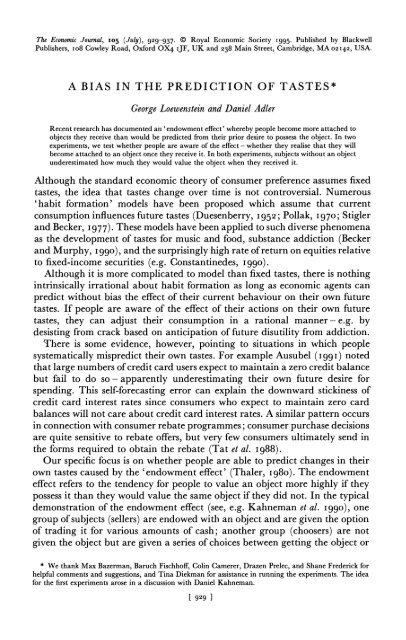
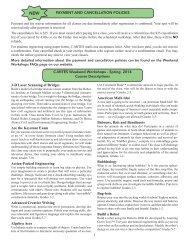
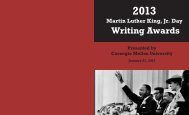
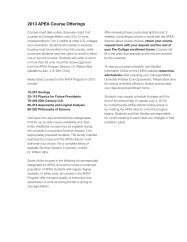

![Pittsburgh Neighborhoods [.pdf] - Carnegie Mellon University](https://img.yumpu.com/22011290/1/190x115/pittsburgh-neighborhoods-pdf-carnegie-mellon-university.jpg?quality=85)
![Curriculum Vitae [.pdf] - Carnegie Mellon University](https://img.yumpu.com/20737100/1/190x245/curriculum-vitae-pdf-carnegie-mellon-university.jpg?quality=85)
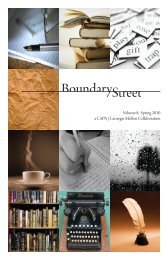
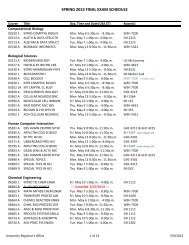
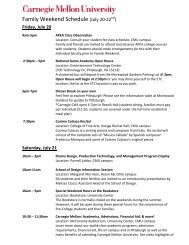
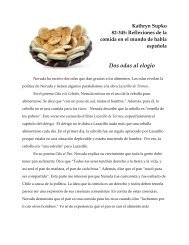


![May 2012 [.pdf] - Carnegie Mellon University](https://img.yumpu.com/12198417/1/190x253/may-2012-pdf-carnegie-mellon-university.jpg?quality=85)
